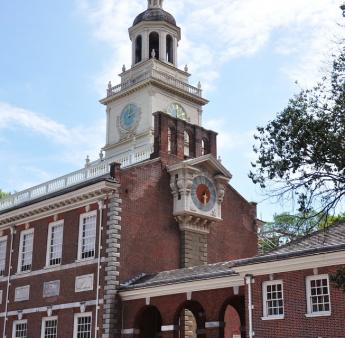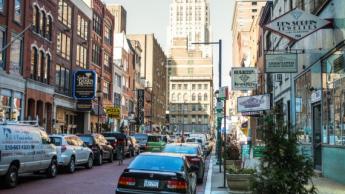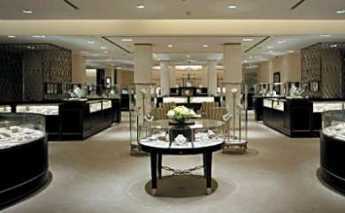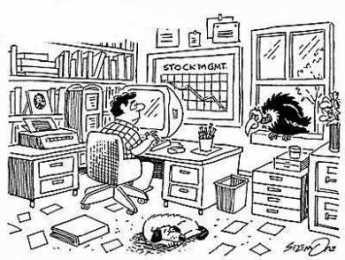Related Topics
Particular Sights to See:Center City
Taxi drivers tell tourists that Center City is a "shining city on a hill". During the Industrial Era, the city almost urbanized out to the county line, and then retreated. Right now, the urban center is surrounded by a semi-deserted ring of former factories.
Tourist Walk in Olde Philadelphia
Colonial Philadelphia can be seen in a hard day's walk, if you stick to the center of town.
Favorite Reflections
 In no particular order, here are the author's own favorites.
In no particular order, here are the author's own favorites.
Up Market Street to Sixth and Walnut
 Millions of eye patients have been asked to read the passage from Franklin's autobiography, "I walked up Market Street, etc." which is commonly printed on eye-test cards. Here's your chance to do it.
Millions of eye patients have been asked to read the passage from Franklin's autobiography, "I walked up Market Street, etc." which is commonly printed on eye-test cards. Here's your chance to do it.
Jewelers Row

|
| Jewelers Row |
Since 1851 Jewelers have clustered on Samson Street mostly between 7th and 8th Streets, and for a block or two in all directions. Sixty years before that, the area had been the site of the most elaborate mansion in America, commissioned by Robert Morris, the Financier of the American Revolution, and built by Charles L'Enfant, the architect of the District of Columbia. About 150 jewelry and jewelry-related businesses are now located in this district, and their outward appearance suggests progressively improving prosperity for them. Some of this reflects the fear of impending inflation (national budget deficits and all that), or a possible decline in the value of the dollar, which amounts to the same thing. During inflationary times, the value of commodities increases; gold and diamonds are the ultimate commodities. In fact, it is widely believed that the price of gold has little to do with jewelry or commodities, and is mainly dependent on the prevailing level of distrust of paper money. For their part, diamonds additionally suit themselves to be hidden in the heel of your shoe if things get tough enough.

|
| Jeweler Shops |
However, J. E. Caldwell's just moved out of the center of the city, and Bailey, Banks and Biddle were sold to people from Texas or somewhere. So the jewelry trade is not universally prosperous, just Samson Street, the Jewelers' Row. Why in the world would 150 little jeweler shops want to cluster together, where people mostly can't tell one from the other, and the products look pretty much alike to anybody who isn't in love and looking for an engagement ring? You would think a competitor next door on either side, and another competitor upstairs, and still others across the street would be something a shrewd merchant would flee, not seek out. Come to think of it, the same thing is true of Antique Row, or the fabric cluster, or a dozen similar clusters in New York City. In New York, it is possible to see a dozen shops next to each other, every one of them selling trombones.

|
| Professor Michael Porter |
Michael Porter of the Harvard Business School has offered an explanation of the economics of a business cluster as an "Innovation cluster". He feels clustering is one of the important ways businesses hold down costs and improve productivity, by innovating rather than merely stressing efficiency. If efficiency and productivity sound like the same thing, it may help to know that efficiency is only a part of productivity, with profitability to the owner of the firm only increasing if the quality of the product steadily improves, which holds up retail prices. Let's put the idea in another way: the innovative, latest and greatest, of any product, commands the highest mark up among similar objects. If you position yourself as producing the latest and greatest, you are going to get a continuously higher markup. In an era of declining prices, the higher markup may express itself as simply maintaining the old prices, so anyway being a part of an innovation cluster assures you of the highest profit available, if you must be in that business. Clusters provide vigorous price competition, all right, and that automatically assures that true prices levels (i.e. after a little bargaining) are likely to be trustworthy measures of value, even in a shabby little hole-in-the-wall. Making jewelry is not rocket science, but there's enough to it that it helps to be located in an area with an abundant supply of skilled and experienced employees. Philadelphia's diamond cluster is the oldest, and still the second largest, jewelry district in the country.

|
| Extra Policing |
Having a lot of portable but largely unidentifiable merchandise concentrated in a few blocks creates a special need for police protection. These shops all have safes, and probably most of them have handguns, but there is a great deal of street traffic among shops, carrying valuable gems in their hip pockets. The City provides extra policing out of recognition of the risk, and the local merchants contribute to hiring extra private detectives to lounge around. When basement flooding at the local electric power substation recently caused a blackout, a lot of extra police were immediately dispatched to Jewelers' Row, just in case somebody got the idea that looting might be attractive. And then it is said, just rumored, that some of the merchants who have plenty of goods loaned to their neighbors on consignment employ private protection of an unlicensed sort, in case they have a problem getting their goods back.
It must be pretty boring to sit all day every day in a little shop that makes one or two sales a week, except at special holidays. One jeweler I know has a portable computer under the counter and spends a lot of time day-trading, which is buying stocks in the morning and selling them in the afternoon. Although competition in the district goes well beyond vigorous, there is an active fraternity of jewelers in the area, steering customers to each other when they don't have a requested item themselves, eating lunch at one of the local bistros, exchanging gossip of the trade, carefully observing the traffic up and down the sidewalks. And then, if there is no traffic they can always have their wives, daughters or neighbors sit on a high stool in front of the counter. Trying on jewelry.
Originally published: Monday, June 26, 2006; most-recently modified: Wednesday, August 07, 2019